Colorful Wedges Baby Blanket
Our Colorful Wedges Baby Blanket embraces the simplicity of garter stitch and throws in the diversion of simple short rows. It’s a wonderful project for dispelling any notions that short rows are difficult, and by the time your blanket is finished, you’ll be a short row pro (if you aren’t one already)!

Our soft and elegant Mulberry Merino works up beautifully in garter stitch and comes in a ton of stunning colors. If you’re like me, you’ll find yourself looking forward to each and every color change… A truly fun project all around!
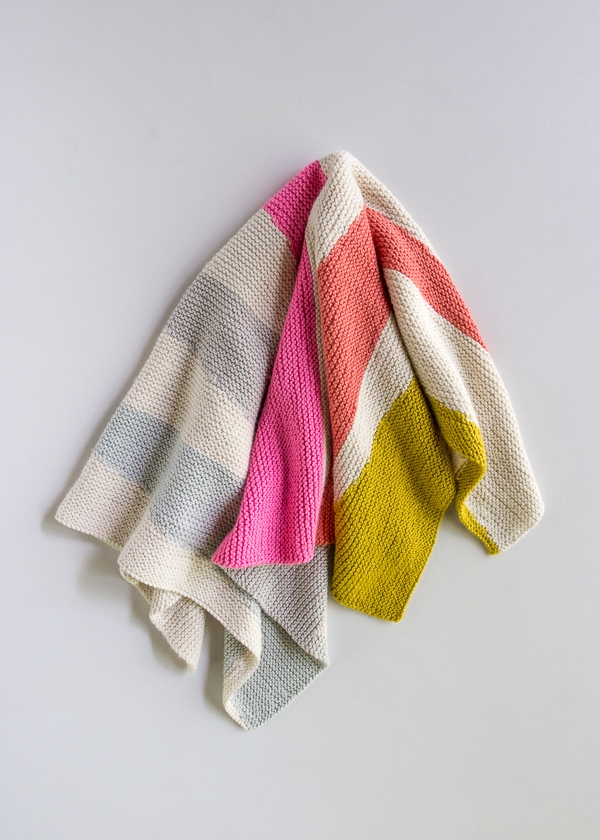
Portable enough to take along on your summer trips, our Colorful Wedges Baby Blanket is knitting at its most stress-free and rewarding! Enjoy! -Kristy
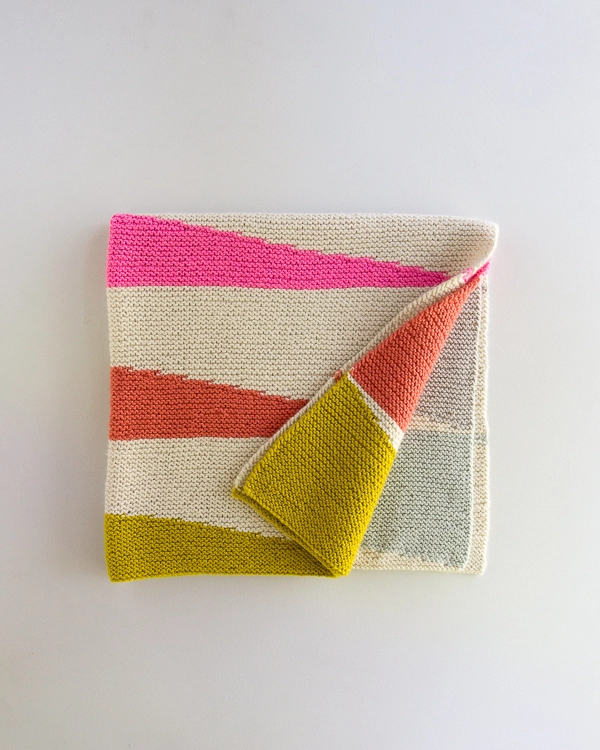
Designed by Purl Soho designer, Kristina McGowan. Click here to see even more of Kristina’s designs!
Share your progress and connect with the community by tagging your pics with #PurlSoho, #PurlSohoBusyHands, and #PurlSohoColorfulWedgesBabyBlanket. We can’t wait to see what you make!
Materials
• 7 skeins of Purl Soho’s Mulberry Merino, 80% extra fine merino wool, and 20% mulberry silk approximately (NOTE: We no longer offer Mulberry Merino, but choose from one of our other sport weight yarns.)
- Color A: 1 skein; approximately 91 yards required
- Color B: 2 skeins; approximately 455 yards required
- Color C: 1 skein; approximately 91 yards required
- Color D: 1 skein; approximately 91 yards required
- Color E: 1 skein; approximately 91 yards required
- Color F: 1 skein; approximately 91 yards required
You’ll also need…
• US 5 (3.75 mm), 24-inch circular needles
Pink Sunrise
Shown from the bottom to the top…
Yarn A: 1 skein of Purl Soho’s Mulberry Merino in Ochre Yellow
Yarn B: 2 skeins of Mulberry Merino in Heirloom White
Yarn C: 1 skein of Mulberry Merino in Pink Grapefruit
Yarn D: 1 skein of Mulberry Merino in Super Pink
Yarn E: 1 skein of Mulberry Merino in Oyster Gray
Yarn F: 1 skein of Mulberry Merino in Artemisia Green
Blue Sky
Shown from the bottom to the top…
Yarn A: 1 skein of Purl Soho’s Mulberry Merino in Black Green
Yarn B: 2 skeins of Mulberry Merino in Heirloom White
Yarn C: 1 skein of Mulberry Merino in Green Turquoise
Yarn D: 1 skein of Mulberry Merino in Peacock Blue
Yarn E: 1 skein of Mulberry Merino in Artemisia Green
Yarn F: 1 skein of Mulberry Merino in Oyster Gray
Gauge
20 stitches and 40 rows = 4 inches in garter stitch
Size
Finished Dimensions: Approximately 30 inches wide x 30 inches long
Notes
Wrp-t: Keeping the yarn in back, slip the next stitch purlwise from the left needle to the right needle. Bring the yarn to the front. Return the slipped stitch to the left needle. Turn the work.
Working wrapped stitches: In this pattern, you do not need to work the wraps with the wrapped stitches. Just knit the wrapped stitches as regular knit stitches.
Pattern
Wedge 1
With Color A, cast on 150 stitches. We used a basic Long Tail Cast On.
Row 1 (right side): Knit to end of row.
Row 2 (wrong side): K144, wrp-t (see Notes, above).
Row 3: Knit to end of row.
Row 4: Knit to five stitches before previous wrapped stitch, wrp-t. (Note: You’ll know you’re wrapping the correct stitch if there are 4 regular knit stitches between wrapped stitches.)
Repeat Rows 3 and 4 until you wrap the fifth stitch from the beginning, and end with Row 3.
Next Row (wrong side): K150 to end of row (see Notes, above).
Cut Yarn A.
Wedge 2
Row 1 (right side): With Yarn B, K5, wrp-t.
Row 2 (wrong side): Knit to end of row.
Row 3: Knit to previous wrapped stitch, knit that stitch, then k4, wrp-t.
Repeat Rows 2 and 3 until you have wrapped the fifth stitch from the end of the row, and end with Row 2.
Next Row (right side): K150 to end of row.
Next Row (wrong side): Repeat the last row.
Cut Yarn B.

Wedges 3 – 10
With Yarn C, repeat Wedge 1.
With Yarn B, repeat Wedge 2.
With Yarn D, repeat Wedge 1.
With Yarn B, repeat Wedge 2.
With Yarn E, repeat Wedge 1.
With Yarn B, repeat Wedge 2.
With Yarn F, repeat Wedge 1.
With Yarn B, repeat Wedge 2, ending one row before the last row.
Bind off all stitches.
Finish
Weave in ends and block as desired.
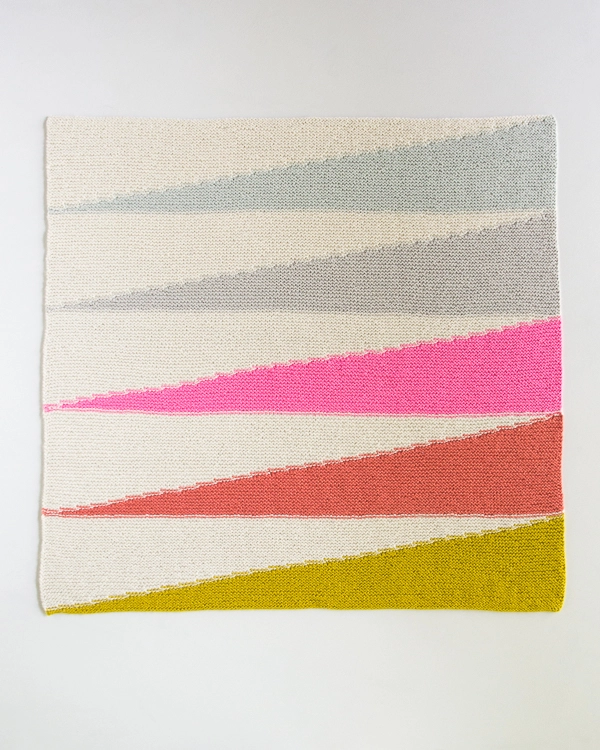


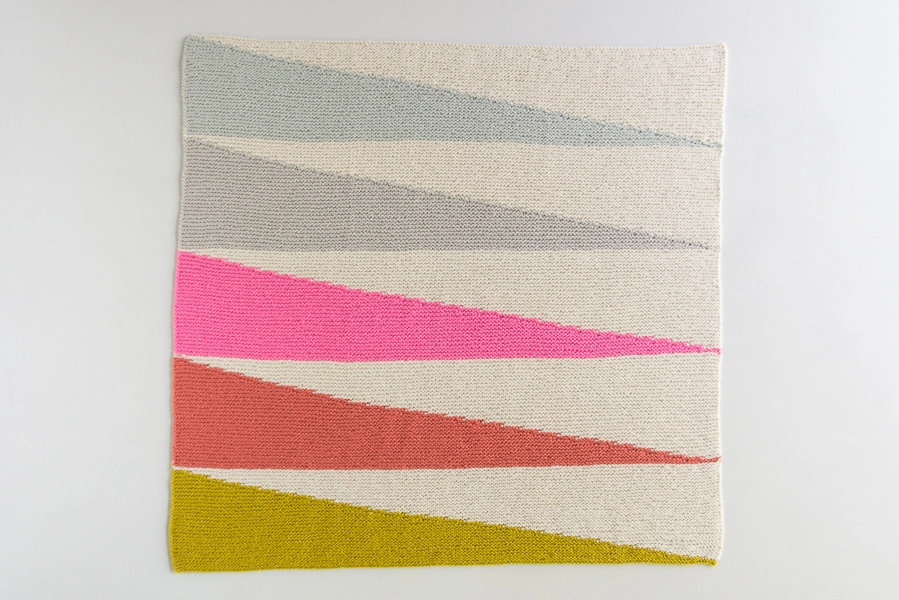


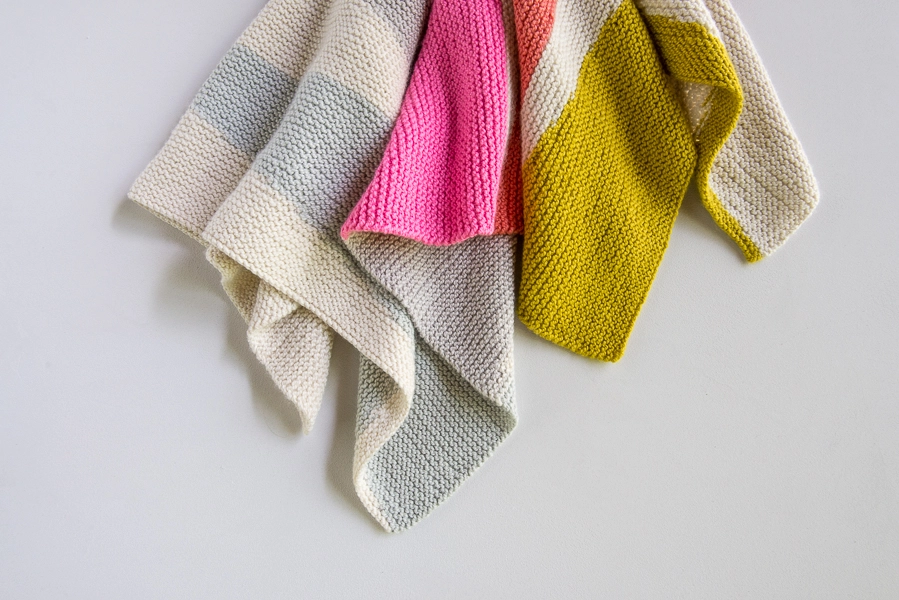
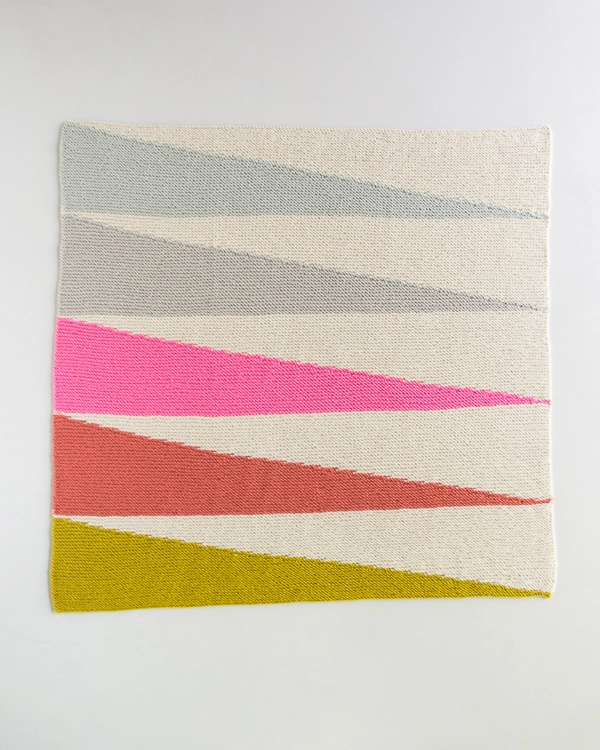


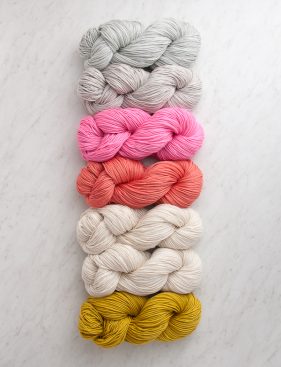
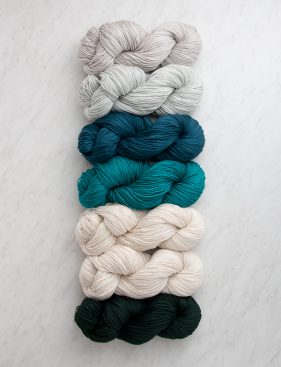

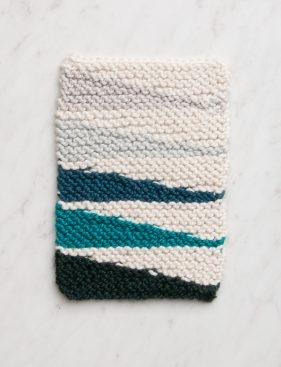



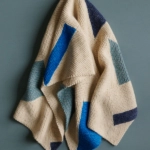
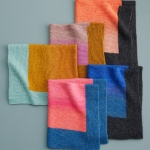
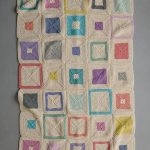
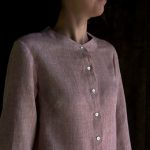

Hi,
Is there a crochet version oh this amazing blanket?
Thanks,
Hi Nancy,
Thanks for writing in! We don’t currently have a crocheted version of this blanket, but I will be sure to pass your request along to the design team!
Best,
Julianna
Hello! Would love to knit this and know the original colors have been discontinued. I’m not great at putting together color combinations, so I’m wondering if you could suggest a couple of colorways (perhaps on the warmer side). Thank you!!!
Hi Anjya,
Thanks for reaching out! For a colorway on the warmer side I would recommend Heirloom White or Wheat Flour for the main color and then Mustard Seed, Turmeric Yellow, Persimmon Orange and Toasted Pecan for the contrast colors!
I hope this helps, happy knitting!
Gianna
Hello! I just knit this gorgeous piece for a friend and loved it so much I’d like to make another for myself, but I’d like to downsize by about a third…To something like a cast on of 100 (?) Maybe then I shrink the stitch progression from five to three (so cast on 99?) ? Or, how would you recommended shrinking the size, by say, a third? Any help thinking through this is greatly appreciated!
Hi Robin,
Thanks for reaching out! I would recommend casting on 100 stitches since the pattern is worked over an even number of stitches!
Please let us know how this turns out and please feel free to reach out if you have any more questions moving forward!
All the best,
Gianna
I misread this and started my yarn A which I intended to be my yarn F- I’m part way through my first wedge of yarn B…. anything I can do to make this right? Or should I just change my colour plan….
Thank you!
Hi Melissa,
Thanks for reaching out! You can either continue on as is and adjust your color plan or you could start over with the color you wanted for Color A!
I hope this helps!
Warmly,
Gianna
I LOVE this pattern, but I just reached the end of my third wedge and it is a lot taller than the first and second wedges. I wrapped the same stitches, and still have the same number as when I started. Is there a reason this might be happening?!
Hi Samantha,
Thanks for reaching out! My best guess is that your tension may have changed a bit and you may be knitting a bit more loosely causing the wedge to be a bit bigger! I would recommend measuring your gauge of this wedge compared to the other to see if the gauge has changed at all! Our tutorial All About Gauge is an excellent resource to use!
I hope this helps and please feel free to reach out with any more questions!
Warmly,
Gianna
1. Ideally I would love to make this in washable wool. Can you make any recommendations?
2. I also love the color choices in the Line Weight Merino. Too fine for this project?
Thank you!
Hi Susan,
Thanks for reaching out! We don’t have a sport weight superwash wool available, however our yarn Cotton Pure is machine washable and is a sport weight like Mulberry Merino!
Line Weight is a bit too light as is, but you could double it up to achieve a similar gauge! Keep in mind though that Line Weight is also a hand wash only yarn!
I hope this helps and please let me know if you have any more questions!
Warmly,
Gianna
Hi, I’m thinking I’d like to knit this blanket but was thinking of trying to use a color way designed for the mitered blanket. Any thoughts ? Thanks
Hi Alice,
Thanks for reaching out! I am happy to assist with this! For this blanket are you planning on using just the color palette of the Mitered Corner Blanket or the yarn as well?
Looking forward to hearing from you!
Gianna
Hi Gianna – I am mostly interested in knitting the blanket with some type of gradient color shift and I thought the mountain color palette could work. I am not attached to using that specific yarn. I guess the other way to think about it would be to knit with 2 yarns and do — aa/ab/bb/bc/cc/cd/dd/de/ee. Does that make sense? What are your thoughts…. It is for a baby blanket so soft and easy to work with would be great… I’m interested in your thoughts and ideas… thanks so much,
Hi Alice,
Thanks for your response! Yes- that makes perfect sense! In that case, I have a few options for you! We love to use our Linen Quill for baby blankets (the same yarn used in the Mitered Corner Blanket!) For this blanket I would recommend holding the yarn doubled throughout, using Heirloom White as the base color and then for colors A-F using 2 colors at once:
A: Oatmeal Gray + Eggshell Blue
B: Eggshell Blue + Green Turquoise
C: Green Turquoise + True Turquoise
D: True Turquoise + Cobalt Blue
E: Cobalt Blue + Crocus Bud
F: Crocus Bud + Lavender Opal
I think this would be a stunning combination and super fun to mix the colors together!
Or you could use the original Mulberry Merino yarn for the blanket, I would recommend Heirloom White for the base and then Light Cerulean, True Turquoise, Inlet Blue, High Tide, Crocus Bud and Cinder Gray!
I hope this helps and please let me know if you have any more questions!
Warmly,
Gianna
I have just finished the first wedge of this blanket. When I knit the wrapped stitches they look real loose. The pattern says to knit the wrapped stitches as regular knit stitches. Any idea as to why this happened? Before I go forward with the second wedge, I wanted to check. Thank you.
Hi Laurie,
Thanks for reaching out! Would you be able to email pictures of your work to our customer service team at customerservice@purlsoho.com? That way, we can see what you’re looking at and troubleshoot from there!
All the best,
Kelsey
Hello,
I would like like to knit this pattern . Is the Mulberry Merino still available? If not, what are the alternatives?
Hi Sylvia,
Thanks for reaching out! Unfortunately, Mulberry Merino has been discontinued, but we have several other Sport Weight yarns that would work great with this pattern! I would suggest using Season Alpaca, Cotton Pure, or even BROOKLYN TWEED Ranch 03! Just be sure to work a gauge swatch prior to beginning to ensure you are consistent with the pattern!
Happy knitting!
Gianna
I love the pattern, but really did not like how the interface between wedges looked when I didn’t knit the wrap along with the wrapped stitch – maybe it was because of the high contrast in my colors. I tore it out and started knitting the wrap with the wrapped stitch. Looked so much better, but was time consuming. So I switched to doing 2-stitch (or German) short rows. I would highly recommend this change for a neater looking edge to the wedges.
Hi there. I am getting read to knit the Wedges blanket. I would like to increase the size to 36 inches. Could you please tell me how many stitches to cast on?
Hi Susan,
Thanks for reaching out. You would need to cast on 180 stitches to make a blanket that’s 36 inches wide!
All the best,
Lili
Thanks for that. Just wondering, then, in the notes I read that the pattern works in multiples of 4 + 2…so would that make it 182 stitches?
Hi Susan,
I’m curious where you’re seeing that! It looks like to me, that this pattern is worked over a multiple of 5 stitches. For the short rows, you’ll be working each wrap + turn five stitches away from the previous one, so 180 stitches will definitely work. Hopefully this clears things up!
All the best,
Lili
An earlier post
Julianna says:
September 10, 2018 at 1:53 pm
Hi Lilian,
Thanks for writing in! You can work this pattern with any multiple of 4 plus 2 stitches, so it should work with a cast on of 110 stitches! You will just have to adjust Row 2 of Wedge 1 to work your wrap and turn 6 stitches from the end of the row. The rest of the pattern should then work as written!
Best of luck and happy knitting!
Julianna
Hi Susan,
Thank you for bringing that comment to my attention! It looks like there was some confusion, and Julianna states in a later comment (from July 29, 2020) that the correct multiple is actually 5:
“Thanks for writing in, and I apologize for the confusion! The correct multiple for this blanket is 5, and you are right that you won’t have the exact same number of stitches outside of the wrap and turns at each end of the wedges – we also had 5 stitches before the first wrap and turn at one end and 4 stitches before the other. You can now knit across all your stitches and start the second wedge instructions!”
Hope this clarifies things!
All the best,
Lili
Hi,
Hoping for some much needed help. I love this pattern but am a bit of a neophyte at this . I finished wedge one and am starting wedge two with the new colour but I’m not sure I understand the instructions. If I knit 5 and then wrap and turn, how do I knit to the end of the row? When i turn i only have 5 stitches on the needle to knit again. So I’m pretty confused as to how I do wedge 2. Can anybody help break down the instructions for me?
Alison
Hi Alison,
Thanks for reaching out. You can think of those 5 stitches as the entire row! Those instructions just mean to knit to the edge (the end of the row) and then turn your work as usual to begin the next short row. With each additional short row, you’ll be “adding” stitches to the row, so the next time the pattern instructs you to knit to the end of the row, the row will have 10 stitches instead of 5, since you added those on the previous short row. I hope this helps clear things up!
All the best,
Lili
Hi,
I read in a reply above that this is knitted over an even number of stitches: If I want to make a larger blanket, by what variable would I increase it? Would it be multiples of 2? 4? etc.
Thank you!
Hi Strix,
Thanks for reaching out. There is some confusion in previous comments, but this blanket is actually worked over a multiple of 5 stitches. So you can increase the stitches by any multiple of 5! I hope this helps.
All the best,
Lili
Thank you, Lili.
I wonder if you could help me make a swatch? I guess like the little ones shown in the pattern.
I don’t know the ‘formula,’ I guess, on how to proceed, after the number of CO stitches I choose.
Thanks for the help!
Hi Strix,
Thanks for reaching out! A good formula to work up a swatch for this pattern would be to cast on multiples of 5, like 30 or 35 stitches. From there you can follow this model:
Wedge 1:
Row 1 (right side): Color A, k6, place marker (pm), knit to end of row.
Row 2 (wrong side): Slip 1, knit to marker, remove marker (rm), wrp-t
Row 3: Slip 1, knit to end of row.
Row 4: Slip 1, knit to 5 stitches before previous wrapped stitch, wrp-t.
Repeat Rows 3 and 4 until you have wrapped the fifth stitch from the beginning.
Repeat Row 3 one more time.
Next Row (wrong side): Slip 1, knit to end of row.
Cut Color A.
Wedge 2:
Row 1 (right side): With Color B, k5, wrp-t.
Row 2 (wrong side): Knit to end of row.
Row 3: Slip 1, knit to previous wrapped stitch, knit that stitch, then k4, wrp-t.
Repeat Rows 2 and 3 until you have wrapped the fifth stitch from the end of the row.
Repeat Row 2 one more time.
Next Row (right side): Knit to end of row.
Next Row (wrong side): Repeat the last row.
Cut Yarn B
Then you will want to repeat Wedge 1, then Wedge 2, as many times as you would like, ending with wedge 2, and then bind off on the right side.
I hope this helps, happy knitting!
Gianna
Wow, thank you so much! Really appreciate it❤️
Hello, I am making my first wedge and I am really confused on how I am to add the white Color.
I understand the first wedge until it says wrap at your last 5 stitches and then knit 150… am I adding the white then?
Is there a YouTube video you could suggest?
Hi Shayla,
Thanks for writing in. You will add in the white yarn after the pattern says to “Cut Yarn A”! So you’ll knit the 150 stitches with Color A, then cut that yarn, and then begin the second wedge with Yarn B (white). All you’ll need to do to start this new color is simply begin knitting Row 1 of Wedge 2 using the new ball of yarn as the working yarn. Hope this helps!
All the best,
Lili
The wraps are causing large gaps in my knitting when I knit back over them with the next color. Is there something that could be causing this? I’ve started over multiple times and am sure I’m following the pattern correctly. Thanks so much!
Hi Chelsea,
Thanks for reaching out. If you’re experiencing large gaps in the knitted fabric, it could be a tension issue! When you work your wrap + turns, you’ll want the tension of the wrap to match the rest of the stitches, but it’s very easy to wrap too tightly. When a wrap is too tight, it pulls the wrapped stitch in one direction, which often leaves a gap once you knit the next row. It may also be helpful to review our tutorial for wrap + turn short rows, just to double check that you’re doing them correctly! Just a note though, our tutorial is for wrap + turn short rows in stockinette stitch, whereas this pattern is in garter stitch. But the only difference is that you don’t have to worry about knitting the wrapped stitches with their wraps when you’re doing them in garter stitch!
All the best,
Lili
Hello!
I finished the blanket (I admit I did not do a gauge – silly of me) and now only have a blanket with 23inch each side. Is there anything I can do to make it bigger yet not destroy your amazing pattern?
I would start over again but I need to knit another one (friends is expecting twins).
Thanks for your help!
Cheers Tina
Hi Tina,
Thanks for reaching out. I would recommend vigorously blocking your blanket! Once the fabric is wet, you’ll be able to stretch it larger so that it’s closer to 30 inches wide, and it will retain this shape as it dries. (Just make sure you’re not too rough with it, or the yarn might felt, depending on what type of fiber you used!)
All the best,
Lili
I’m interested in making this blanket for a baby girl with Season Alpaca yarn. Can you help me build a color way around these colors: Wild Lupine, Purple Foxglove and Lilac Quartz? I’m not sure what color to choose as my Yarn B, or for the other two colors needed to complete this pattern. Thank you!
Hi Jen,
Thanks for reaching out! I would love to help you select a color pallet! I would suggest using Heirloom White or Dove Gray for Color B, and then Wild Lupine, Purple Foxglove, Lilac Quartz, Mountain Rose, and Red Plum.
I hope this helps, happy knitting!
Gianna
This is going to be beautiful! Thanks so much for your recommendation!
I would love to make this blanket for my granddaughter in the Cotton Pure not on the cone. I love the vibe of the original. What colors would you suggest for the Cotton Pure to get that vibe? And how many skeins would I need of each. Thank you so much!
Hi Jennifer,
Thanks for reaching out. I’d be happy to recommend some colors of Cotton Pure that will match the original color palette of this blanket! Here’s what I’m thinking:
Color A: Jonquil Yellow (1 skein)
Color B: Heirloom White (2 skeins)
Color C: Rosy Red (1 skein)
Color D: Beach Rose (1 skein)
Color E: Gray Birch (1 skein)
Color F: Silver Quartz (1 skein)
I hope this helps you plan your project!
All the best,
Lili
Thank you so much Lili! I feel confident to make a beautiful Colorful Wedges blanket because of your help. And, I just ordered all the yarn you suggested! This will be my 7th grandchild for whom to knit a blanket. So special.
I really appreciate your time and help,
Jennifer
Hi!
I’m making this blanket for my baby niece, but I think I may have bought the wrong yarn. I *thought* that the super soft merino was in the sport weight category but it doesn’t show up on the link anymore. I started the project with the merino but it seems like I will have to buy double the amount of yarn for each color.
What would you suggest? Should I send back the yarn I bought and try a different yarn?
Hi Jo,
Thanks for reaching out. This blanket was originally designed for Mulberry Merino, but we’ve since discontinued that yarn! Super Soft Merino is a chunky/bulky weight yarn, so it’s quite a bit thicker than Mulberry Merino was.
But you can absolutely return your yarn in exchange for a sportweight yarn! I’d recommend using Wigeon or Season Alpaca, as those are the closest yarns we currently carry to the original.
When you’re ready to send the Super Soft Merino back, just ship it to us at the following address:
Purl Soho
2710 S Main Street
Suite A
Santa Ana, CA 92707
Please make sure to include in your return package a note with your name and order number. If you no longer have your order number on hand, please include the following: your name, email address, and phone number. Please also include a note indicating exactly what yarn/colors/quantities you’d like in exchange! Once we receive your package, we’ll go ahead and send the new yarn directly to you and charge or refund your method of payment for any difference in price.
Please let us know if you have any questions about this process!
All the best,
Lili
If I wanted to adjust this pattern for DK weight instead of sport… would you recommend casting on fewer stitches, and how many should I cast on in order to make this pattern work? Would it be simple enough- mathematically- to adjust? Help would be so appreciated, thank you! 🙂
Hi Carli,
Thanks for reaching out. To figure out your cast-on number with DK weight yarn, you will want to first knit a gauge swatch in pattern with your needles of choice (if this is daunting, we have a wonderful tutorial called All About Gauge). Once you know how many stitches you are getting per inch, you can multiply that number by the width of the blanket (30 inches) and cast on the nearest multiple of 5 stitches. Then you can follow the pattern as written!
All the best,
Lili
I think I may have made a mistake – I knitted to 5 stitches prior to the last wrapped stitch and then wrapped the next stitch. This gives me sections of 4 stitches, then a gap due to the wrap, then 4 more. Did I misunderstand?
Hi Megan,
Thanks for reaching out! It sounds like you’ve been knitting one too many stitches before working your wrap + turn. Once you’ve knit up to 5 stitches before the previously wrapped stitch, there should be, on your left needle, the previously wrapped stitch, followed by 5 normal stitches. Then, when you wrap this 5th stitch, you’ll end up with groups of 5 stitches separated by the gaps from each wrap. Hope this helps clear things up!
All the best,
Lili
hello!
I would like to make this a little bit smaller, like reduce by 25 %…
How could I adjust the numbers? Cast on 100?
maybe only do 8 wedges ?
Would this work
Hello,
Thanks for reaching out! To reduce the size by 25%, I’d recommend casting on 110 or 115 stitches. This pattern works over a multiple of 5 stitches, so either 110 or 115 will work, and those are the two multiples of 5 that are closest to 25% of the original 150 stitch cast-on.
Then you can essentially follow the pattern as written, and your blanket will also come out 25% shorter, since you’ll be knitting fewer rows per wedge! On Row 1 of WEDGE 1, you’ll just need to make sure you’re wrapping and turning on the 6th stitch from the end of the row. Hope this helps!
All the best,
Lili
I LOVE this pattern!! Could you help me figure how to make this in the size of a throw?
Hi Caitlin,
Thanks for reaching out! This pattern works over a multiple of 5 stitches, so to make a larger blanket, just cast on more stitches, making sure that the stitch count is a multiple of 5. From there, you can follow the pattern as written, and the only change you’d need to make would be on Row 2. You can work Row 2 like this:
Row 2 (wrong side): Knit to last 6 stitches, wrp-t.
I hope this helps!
All the best,
Lili
Hi there, I’d like to make this with a medium (4) 100% cotton yarn. The packaging says gauge is 20 sts – 26 rows = 4″ with size 7 needles. I would say I am a tight to average tension knitter. I don’t mind it being a little bigger than original (up to 36″ would be fine). Any idea if I should cast on less and what the new yardages would be? Whether the pattern would need to change? Thanks so much!!
Hi Mariah,
Thanks for reaching out! I would recommend starting by knitting a gauge swatch. That way, you can see exactly what your tension is and adjust accordingly! The easiest thing to do, rather than adjust the pattern itself, is to change your needle size so that you can match the gauge of the pattern more closely (even if it’s not exact). The gauge of this pattern is 20 stitches per inch, so it sounds like you could absolutely make that work with the yarn you have. Hope this helps!
All the best,
Lili
Hi! I’m new to wrp-t, but I watched the PS tutorial. I thought all made sense, but trying it out on Wedge 1 at the end of row 2, I’m ending up with 6 stitches on the right (before knitting back across on Row 3) Looking through your team’s previous answers to this question, I should have 5. Can you tell me what I’m doing wrong?
Hi Audrey,
Thanks for reaching out! You should have 5 normal stitches and one wrapped stitch to the right before you knit back across for Row 3. Are these the 6 stitches you’re seeing? If so, what you have is correct!
However, if you have a total of 7 stitches (6 normal stitches and 1 wrapped stitch), then all that means is you need to knit one additional stitch before working the wrp-t. Hope this helps clear things up!
All the best,
Lili
Hi! I’ve started this blanket. But for some reason all of my Wedge 2 wedges are smaller than the Wedge 1 wedges. Wedge 1 has what looks like 36 rows, and wedge 2 has about 29 rows. Any idea what I’m doing wrong??
Hi Caitlin,
Thanks for reaching out, although I’m sorry to hear that your wedges are coming out at different sizes! Would you be able to send a photo of your work to customerservice@purlsoho.com? That way, we can better visualize what’s going on!
All the best,
Lili
Hello, I came across this pattern whilst looking for something to knit for my great nephew 💙
Just wondered if anyone has tried this pattern using a thicker yarn, i.e. dk or worsted and if it looked just as good.
Hi Leyla,
We haven’t tried it ourselves, but you could absolutely use a thicker yarn for this pattern! You’d just need to modify the number of stitches you cast on to ensure that the blanket comes to the correct size.
To figure out your cast-on number with any other weight of yarn, you will want to first knit a gauge swatch in pattern with your needles of choice (if this is daunting, we have a wonderful tutorial called All About Gauge). Once you know how many stitches you are getting per inch, you can multiply that number by the width of the blanket (30 inches) and cast on the nearest multiple of 5 stitches. Then you can follow the pattern as written!
All the best,
Lili
Thank you so much for the reply, and the tips on how to work out the number of stitches to cast on for a different weight yarn. 😀
I would like to use some stash yarn to make this pattern and I have a fingering gradient that I think would work nicely. I have 5 fingering weight skeins that are superwash merino single ply (is this a terrible idea for a baby blanket?), each skein has 150 yards. I’m thinking if I use a smaller needle and add more stitches, that might be appropriate? Could you give me some advice?
Hi Lindsay,
Thank you for writing in! I would recommend knitting a gauge swatch with the recommended needle size to attempt the gauge of the pattern first. That way you can get an idea of the fabric to see how you like it and if you can continue without further adjustments. I hope this helps!
Happy knitting,
Gavriella
Such a lovely pattern!
would it be possible to knit this in stocking stitch (stockinette) instead of garter stitch?
Hi Sue,
Thank you for writing in! That’s a great question. Although that sounds like a lovely idea, we don’t recommend knitting this pattern in stockinette as it would change the size of the wedges and would likely cause the blanket’s shape to change. I hope this helps but please let me know if you have any other questions!
All the best,
Gavriella